NEO 2007 TU24 flyby
(Images taken by others)
images taken by Elizabeth Warner, Univ. of Maryland
On Monday, 28 January, I went to the observatory and got the C14 and my 6" refractor set up with the cameras and computers. I had ephemerides from JPL and MPC and started taking series of pics. I first used the JPL coordinates that I had, but nothing showed up in the images. For the third set of pics that I took with my telescope, I used MPC coordinates. Unfortunately, I was running back and forth between the two scopes, so I didn't watch the images as they were downloaded. However, at the end of the set, when I reviewed it, a streak showed up in the first frame. I then moved the telescope to the next time hack and took a single frame. Bingo! Moved it again and took pics until I got another streak. With my scope, I got four images. In the C14, with the smaller field of view, we have a streak in one of the frames, but I didn't process that one.
All images were taken with an AP 152mm f/9 telescope with an SBIG ST-7 using the clear (L) filter from their tricolor filter set. North is at right and East is at top. Unfortunately, I got frustrated near the end of the session because I 'lost' the asteroid and couldn't get it back in the field and then clouds rolled in. I basically forgot to take the flats. The blotch is ice forming on the chip -- we were overdue on drying out the camera desiccant.
So here are the four frames:
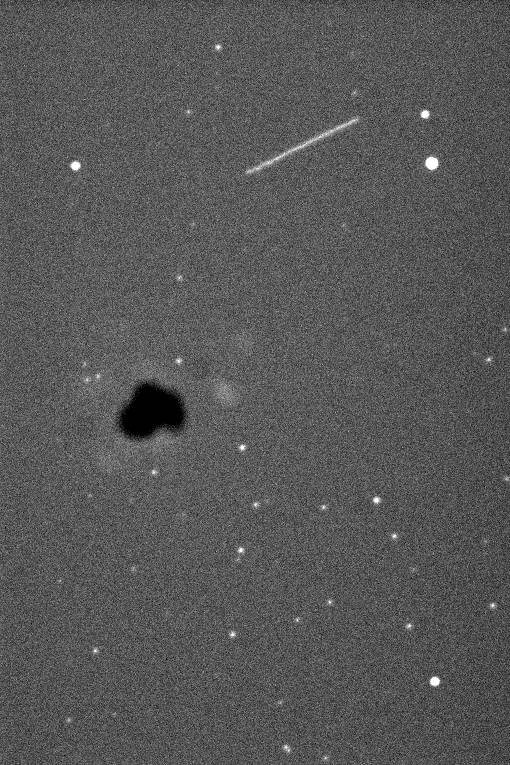 |
exposure: 60s
processing: bias and dark subtracted time: 00:44:24 (UT) aimed at: 01h42m00s, +37°40'00" (interpolated between the 7:30 and 8pm coordinates) bright star(s) in fov: TYC 2815-1014-1 comments: |
 |
exposure: 120s
processing: bias and dark subtracted time: 01:19:11 (UT) aimed at: 01h44m00s, +39°00'00" (interpolated between the 8 and 8:30pm coordinates) bright star(s) in fov: TYC 2815-17-1 comments: |
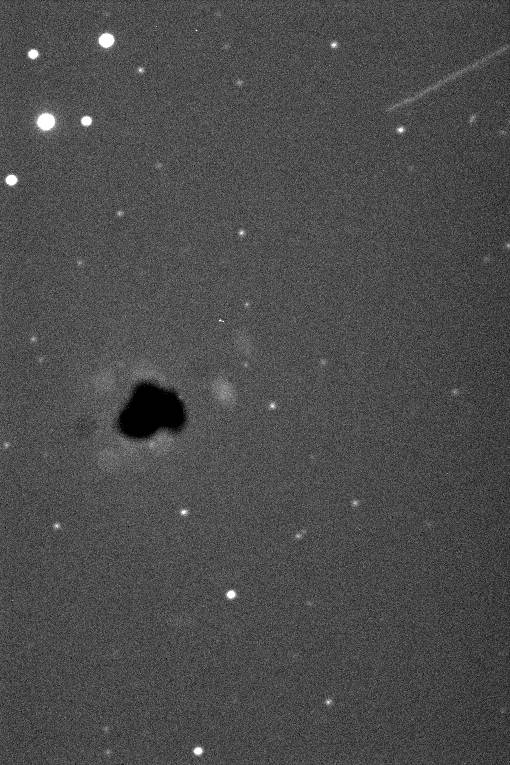 |
exposure: 120s
processing: bias and dark subtracted time: 01:31:26 (UT) aimed at: 01h45m52s, +39°40'03" (8:30pm coordinates) bright star(s) in fov: HIP 8238, HIP 8248 comments: |
 |
exposure: 120s
processing: bias and dark subtracted time: 01:45:48 (UT) aimed at: 01h48m38s, +41°00'35" (9pm coordinates) bright star(s) in fov: TYC 2819-275-1, TYC 2819-605-1 comments: Hmm, might this be something else?? Note the difference in time taken and the coordinates used... the first three matched very closely, but this one is off. Also, the first three have pretty much the same slope and this one is different. So maybe this is something else, clearly something a bit brighter! Any one have any thought?? But we are looking further north ... field rotation... perspective... |
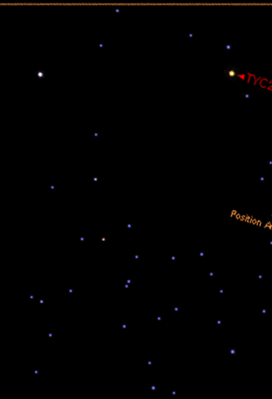 |
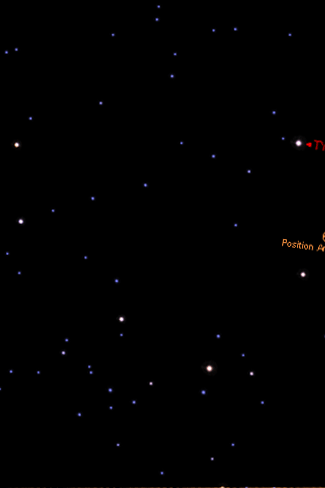 |
These are the first 2 images blinked with the matching starfield from Starry Night (SNP+6.2.1). | |

Graphic from SNP+ showing the area. Grey boxes are the four images embedded. The red line is the path of TU24 through the sky based on MPC elset from later Monday evening. The time hacks on the red line are where the asteroid supposedly was at those times. I certainly won't deny that there might be some user error in getting the orbital elements from the MPC and entering them in SNP+, but there still seems to be a pretty good discrepancy between the supposed position and when I took the frames. The lowest grey box is the first frame at about 7:45pm. The top box is the last frame at about 8:45pm.
Images from others
I do not know all of the details (equipment, orientation, exposures...) for these images...

Gary Emerson: During the past couple of days, a minor planet that is classed as a Near Earth Object (NEO), passed close to the Earth (and missed). This NEO is about 900 feet long and came within 1.4 times the distance of the moon.
This image is a composite of 50 5-sec. exposures.
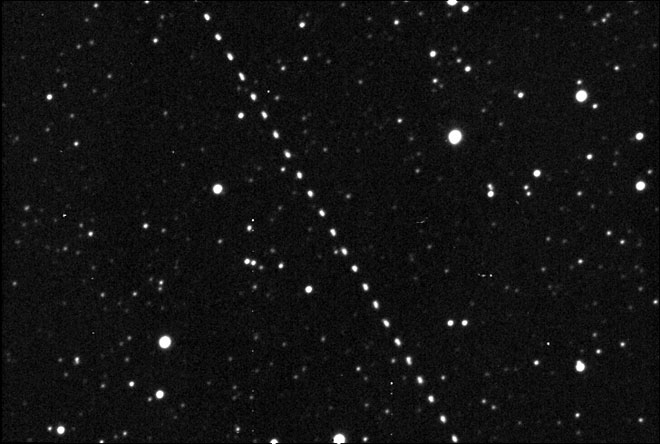
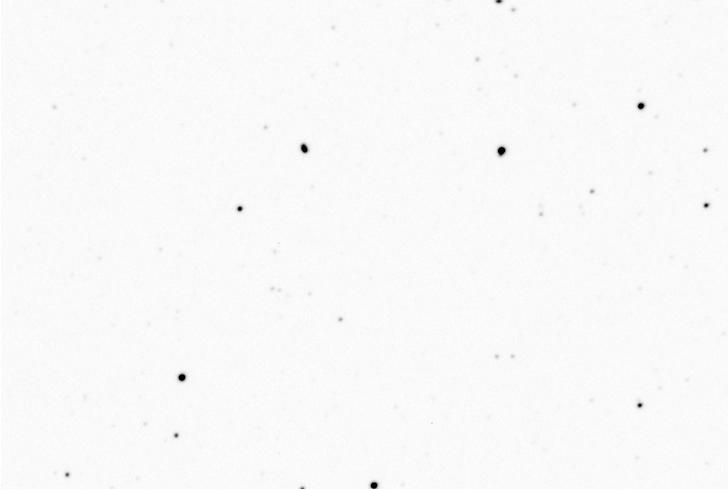
A set of images was taken by Patrick Wiggins who posted the information (msg below) to the Minor Planet Mailing List (MPML). Others on the list then posted animations using Patrick's set of images... Top image is from Patrick. The animation was generated by Michael Richmond.
Patrick:
I managed to get 3 series of 2007 TU24 while it was visible through haze in a sucker hole. Despite the haze I was lucky to get what I did as it was snowing earlier tonight and the sucker hole has since closed and snow is predicted to resume later this morning. Images in this series were taken between 2007 JAN 29 06:49:15 and 06:52:35 UT. 25 two second exposures through C-14 @ f/11, ST-10, binned 3x3, -25°, aligned and stacked. FOV is 13' x 9'.
Michael:
You can find several files created from Patrick's images at http://spiff.rit.edu/richmond/temp/ I registered all the images, then combined them in several ways. A sum of all the images (shows asteroid moving through field) tu24_sum.fit tu24_sum.gif A median of all the images (no asteroid, just stars) tu24_median.fit tu24_median.gif Animations showing the asteroid moving through the field tu24_anim.gif tu24_anim.mpg Looks great! Thanks to Patrick for sharing his images. Michael Richmond
Animations from Adam Stuart (Miami, Florida USA)
"Captured and posted more for posterity as my sequences are short due to bad weather the evening of January 28th, 2008."
+ http://uk.youtube.com/watch?v=zbbgowfKJfA
+ http://uk.youtube.com/watch?v=pNVqZMK7OsU
Images and animations from Gerhard Dangl
+ website (in German), MPML msg
Images sent to Spaceweather.com